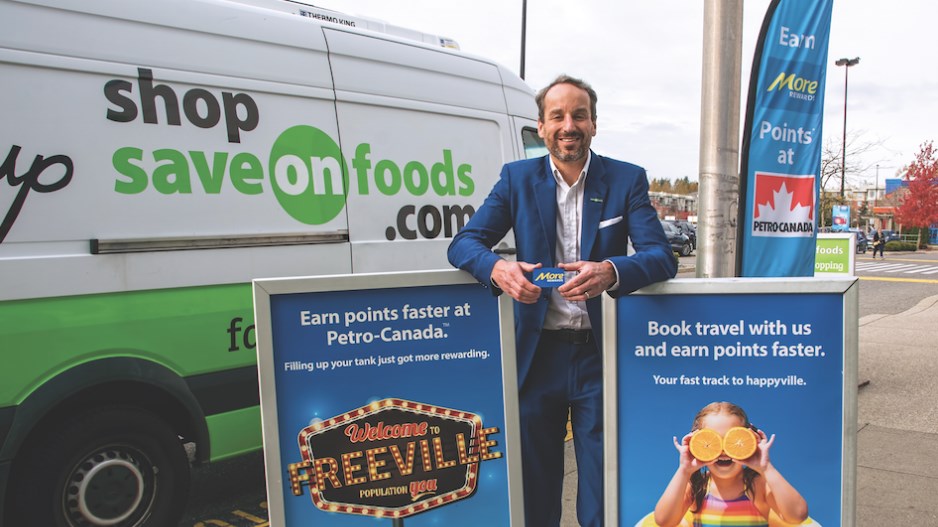Technology has advanced to the point where it is cost-effective for even medium-sized retailers to send personalized marketing messages and discounts to individual shoppers based on shopping data.
The key is to get customers to be willing to join a loyalty program.
Shoppers’ data is usually collected each time customers use a loyalty program to either earn points or be credited with a visit to a store when they buy goods.
The result of more advanced and cheaper technology, combined with consumer demand for such programs, is that many B.C. companies are either creating their own customer-loyalty programs or partnering with existing programs to show customers that they value their business.
Shopper analytics giant Loyalty-One earlier this year estimated that global spending directly into loyalty programs and other ways of managing customer relationships is about $126 billion annually.
“A big game-changer today is that as the generations have changed, and mobile and other technologies have matured, customers are expecting to be communicated with on an individual basis, and they want discreet or individualized offers based on their own shopping patterns,” London Drugs president and COO Clint Mahlman told Business in Vancouver.
“Customers are much more willing today to give a retailer, or a business, their personal data, but they expect in return something that is going to add value to them.”
Mahlman helped launch London Drugs’ LDExtras program three years ago and has quickly expanded the initiative to more than one million members. Mahlman said London Drugs held off setting up its loyalty program until 2016, after many of its competitors had already launched their own programs, because the technology was not cost-effective before then.
The College of Pharmacists of BC had also previously launched court challenges to stop retailers from providing incentives or loyalty-program points for prescriptions or other pharmacy purchases.
Another cause for delay was the complexity presented by London Drugs’ wide range of prices for products – from a $10,000 television to a $1 chocolate bar.
The solution was to create a London Drugs program based on customers being credited with a “visit” each time they spend $10, instead of getting a point for each dollar, as is the case with most loyalty programs.
Mahlman added that visit-based loyalty rewards were preferable to a points-based one because the company did not want to go down the road that some loyalty programs have taken. Programs such as Loyalty-One-owned Air Miles, for example, have had to have points either expire or be devalued.
“The last thing you want to do is have a loyalty program that pisses people off,” said retail analyst and Retail Insider Media owner Craig Patterson. “That defeats the whole purpose of the program.”
He said that Air Miles’ devaluation of loyalty points angered people not only because points were worth less but also because there were new restrictions on what prizes, or vacations, the points could buy.
A public relations representative for Air Miles sent BIV an email to clarify that the program's points are not "devalued," but that they rather "fluctuate" in value. She added that points do not expire. If, however, a collector goes two years without using the program, the points become "dormant."
The Jim Pattison Group has operated its More Rewards program for more than 25 years but has never devalued its points – and it has no plans to do that, said Dan Howe, who had been running the program as vice-president and was promoted in October to president of the division.
While More Rewards operates within Pattison’s Save-On-Foods subsidiary, there is a chance that in time More Rewards will break out and become its own operating division within the conglomerate, Save-On-Foods president Darrell Jones told BIV in early October.
Program members earn points each time they make purchases at a wide variety of Pattison-owned companies in addition to companies that operate outside the group, such as Petro-Canada, Coast Hotels and Panago Pizza.
“The goal is to get, in the next three years, five large chains and between 10 and 15 medium-sized chains as partners,” Howe told BIV.
More Rewards has more than 3.5 million members, with 83% of those shoppers using their membership in the past year, Howe added.
Most of its agreements with partners are that the partners pay the program to buy points, and then the partner businesses provide those points to their customers.
More Rewards then buys products from its partners to provide to program members when members redeem points for rewards at the partner retailers.
Newcomers to the More Rewards program tend to fall into one of three categories, Howe said. They either:
•do not have a program;
•are part of a program that they are not happy with; or
•want to keep their current program and be part of the More Rewards program in order to offer increased options for customers.




